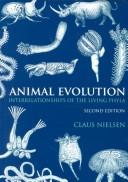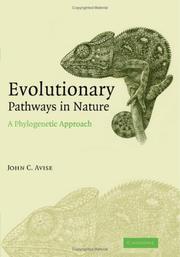| Listing 1 - 10 of 45 | << page >> |
Sort by
|
Book
ISBN: 9535143336 9535102176 Year: 2012 Publisher: IntechOpen
Abstract | Keywords | Export | Availability | Bookmark
 Loading...
Loading...Choose an application
- Reference Manager
- EndNote
- RefWorks (Direct export to RefWorks)
Mapping phylogenetics on geographical scales is one of the most important scientific aspects of bioscience research. Changes in the environment have evidently shaped the geographical distribution of organisms on land and in the oceans seen today. Overexploitation of key species has caused not only changes in the distribution and diversity of organisms and composition of the ecosystems, but is also leading to species extinction at accelerating rates. It is our duty as scientists to find ways of protecting the species endangered with extinction and preventing other species from entering the endangered stage. To manage this effectively, we need to map species distribution, understand life-history traits, define genetic variation within species and populations, identify lineages - especially at the molecular level - and correlate the historical, phylogenetic components with the spatial distributions of gene lineages. In this book, phylogenetics and phylogeography of a diverse range of organisms are reviewed: from microorganisms causing gastroenteritis in humans, fishes in the Southwest Atlantic Ocean and spiders of the western Indian Ocean, to mountain tapirs in South America and birch tree species of the Arctic tundra.
Phylogeny. --- Animal phylogeny --- Animals --- Phylogenetics --- Phylogeny (Zoology) --- Biology --- Evolution (Biology) --- Phylogeny --- Life Sciences --- Plant Biology --- Agricultural and Biological Sciences --- Ecohydrology
Book
ISBN: 9535135023 953513499X 9535146637 Year: 2017 Publisher: IntechOpen
Abstract | Keywords | Export | Availability | Bookmark
 Loading...
Loading...Choose an application
- Reference Manager
- EndNote
- RefWorks (Direct export to RefWorks)
Phylogenetics aims to study the evolutionary relatedness of living organisms in our planet. Its application is extended to the key areas such as evolution, classification and taxonomy of living organisms; ecology, diversity, and conservation biology of agrobiocenosis; monitoring of pathogen spread, outbreaks and source of transmissions, forensic analyses, etc. Historically, phylogenetics studies were prevalently based on morphological features of species that helped to classify the 'Tree of Life' on Earth. Modern phylogenetics studies, however, rely more heavily on DNA sequences. In this Phylogenetics book, we aimed to present readers the latest developments in phylogenetics studies that highlight multi-kingdom systems, reticulated evolution and conservation biology of living organisms as well as 'omics'-based phylogenetics advances.
Phylogeny. --- Animal phylogeny --- Animals --- Phylogenetics --- Phylogeny (Zoology) --- Biology --- Evolution (Biology) --- Phylogeny --- Life Sciences --- Microbiology --- Genetics and Molecular Biology --- Biochemistry --- Microbial Genetics
Book
ISBN: 0123799503 9780123799500 Year: 1972 Publisher: London: Academic press,
Abstract | Keywords | Export | Availability | Bookmark
 Loading...
Loading...Choose an application
- Reference Manager
- EndNote
- RefWorks (Direct export to RefWorks)
Evolution. Phylogeny --- Metazoa --- Evolution (Biology) --- Phylogeny --- Animal phylogeny --- Animals --- Phylogenetics --- Phylogeny (Zoology) --- Biology --- Animal evolution --- Biological evolution --- Darwinism --- Evolutionary biology --- Evolutionary science --- Origin of species --- Evolution --- Biological fitness --- Homoplasy --- Natural selection --- Metazoa. --- Phylogeny. --- Evolution (Biology). --- Metazoans --- Multicellular animals
Book
ISBN: 1280846267 0191513733 1429469277 9780191513732 9781280846267 1383029504 Year: 2005 Publisher: Oxford New York Oxford University Press
Abstract | Keywords | Export | Availability | Bookmark
 Loading...
Loading...Choose an application
- Reference Manager
- EndNote
- RefWorks (Direct export to RefWorks)
"This book considers evolution at different scales. The focus is on the mathematical and computational tools and concepts, which form an essential basis of evolutionary studies, indicate their limitations, and give them orientation"--Provided by publisher.
Evolution (Biology) --- Phylogeny --- Mathematics. --- Animal phylogeny --- Animals --- Phylogenetics --- Phylogeny (Zoology) --- Animal evolution --- Biological evolution --- Darwinism --- Evolutionary biology --- Evolutionary science --- Origin of species --- Evolution --- Biology --- Biological fitness --- Homoplasy --- Natural selection
Book
ISBN: 9780199606030 9780199606023 019960603X 0199606021 1283426803 0191625302 9786613426802 9780191625305 9780191774706 0191774707 9781283426800 6613426806 Year: 2012 Publisher: Oxford
Abstract | Keywords | Export | Availability | Bookmark
 Loading...
Loading...Choose an application
- Reference Manager
- EndNote
- RefWorks (Direct export to RefWorks)
Animal Evolution is a complete analysis of the evolutionary interrelationships and myriad diversity of the animal kingdom. This new edition brings the subject fully up to date, especially in light of the latest advances in molecular techniques. It also includes new chapters as the result of new systematic understanding.
Phylogeny --- Evolution (Biology) --- Phylogenèse --- Evolution (Biologie) --- Phylogeny. --- Phylogenèse --- Evolution (Biology). --- Animal evolution --- Animals --- Biological evolution --- Darwinism --- Evolutionary biology --- Evolutionary science --- Origin of species --- Biology --- Evolution --- Biological fitness --- Homoplasy --- Natural selection --- Animal phylogeny --- Phylogenetics --- Phylogeny (Zoology) --- Phylogénie. --- Animaux --- Évolution
Book
ISBN: 0471907545 9780471907541 Year: 1987 Publisher: Chichester: Wiley,
Abstract | Keywords | Export | Availability | Bookmark
 Loading...
Loading...Choose an application
- Reference Manager
- EndNote
- RefWorks (Direct export to RefWorks)
Phylogeny --- Biology --- Classification --- -Phylogeny --- Animal phylogeny --- Animals --- Phylogenetics --- Phylogeny (Zoology) --- Evolution (Biology) --- Life sciences --- Biomass --- Life (Biology) --- Natural history --- Biosystematics --- Organisms --- Systematic biology --- Systematics (Biology) --- Taxonomy (Biology) --- Taxonomists --- Biology - Classification --- Phylogeny of animals

ISBN: 0198548672 0198548680 9780198548676 9780198548683 Year: 1997 Publisher: Oxford: Oxford university press,
Abstract | Keywords | Export | Availability | Bookmark
 Loading...
Loading...Choose an application
- Reference Manager
- EndNote
- RefWorks (Direct export to RefWorks)
"Animal Evolution is a complete analysis of the evolutionary interrelationships and myriad diversity of the animal kingdom. Using modern phylogenetic reasoning based on characters from an extensive review of morphology, including ultrastructure, and embryology, each phylum is analysed to ascertain its monophyly and hence its ancestral characters. These ancestral characters are then used to construct a complete phylogenetic tree of the extant animal phyla. This new edition of Animal Evolution brings the subject fully up to date including some new ideas and emphases, as well as new bibliographic data."--BOOK JACKET.
Evolution (Biology). --- Phylogeny. --- Phylogeny --- Evolution (Biology) --- Phylogenèse --- Evolution (Biologie) --- Animal evolution --- Animals --- Biological evolution --- Darwinism --- Evolutionary biology --- Evolutionary science --- Origin of species --- Biology --- Evolution --- Biological fitness --- Homoplasy --- Natural selection --- Animal phylogeny --- Phylogenetics --- Phylogeny (Zoology)

ISBN: 0521857538 0521674174 9780521857536 9780521674171 9780511606939 0511219318 9780511219313 9780511221286 0511221282 0511219997 9780511219993 0511220510 9780511220517 0511606931 128048022X 9781280480225 1107166748 9786610480227 0511324251 9781107166745 6610480222 9780511324253 Year: 2006 Publisher: Cambridge Cambridge University Press
Abstract | Keywords | Export | Availability | Bookmark
 Loading...
Loading...Choose an application
- Reference Manager
- EndNote
- RefWorks (Direct export to RefWorks)
Reconstructing phylogenetic trees from DNA sequences has become a popular exercise in many branches of biology, and here the well-known geneticist John Avise explains why. Molecular phylogenies provide a genealogical backdrop for interpreting the evolutionary histories of many other types of biological traits (anatomical, behavioral, ecological, physiological, biochemical and even geographical). Guiding readers on a natural history tour along dozens of evolutionary pathways, the author describes how creatures ranging from microbes to elephants came to possess their current phenotypes. Essential reading for college students, professional biologists and anyone interested in natural history and biodiversity, this book is packed with fascinating examples of evolutionary puzzles from across the animal kingdom; how the toucan got its enormous bill, how reptiles grow back lost limbs and why Arctic fish don't freeze.
Evolution (Biology). --- Phylogeny. --- molecular phylogeny --- evolutionary ecology --- evo-devo (evolutionary developmental biology) --- Evolution (Biology) --- Animal evolution --- Animals --- Biological evolution --- Darwinism --- Evolutionary biology --- Evolutionary science --- Origin of species --- Biology --- Evolution --- Biological fitness --- Homoplasy --- Natural selection --- Phylogeny --- Animal phylogeny --- Phylogenetics --- Phylogeny (Zoology)
Book
ISBN: 9781138332935 1138332933 9780429446276 0429446276 9780429821196 0429821190 9780429821219 0429821212 9780429821202 0429821204 Year: 2020 Publisher: Boca Raton CRC Press Taylor & Francis Group
Abstract | Keywords | Export | Availability | Bookmark
 Loading...
Loading...Choose an application
- Reference Manager
- EndNote
- RefWorks (Direct export to RefWorks)
"Nearly 300 clades - lineages of organisms - will be defined by reference to hypotheses of phylogenetic history rather than by taxonomic ranks and types. This volume will document the Real World uses of PhyloCode and will govern and apply to the names of clades, while species names will still be governed by traditional codes"--
Cladistic analysis. --- Phylogeny --- Nomenclature. --- Cladistic analysis --- Animal phylogeny --- Animals --- Phylogenetics --- Phylogeny (Zoology) --- Biology --- Evolution (Biology) --- Cladism --- Cladistic method --- Cladistic taxonomy --- Cladistics --- Cladograms --- Phylogenetic systematics --- Phylogenetic taxonomy --- Taxonomy, Cladistic --- Taxonomy, Phylogenetic --- Branching processes --- Nomenclature --- Classification --- Evolution. Phylogeny --- Animal systematics, taxonomy, nomencl.
Book
ISBN: 9782807329959 2807329950 Year: 2020 Publisher: Louvain-la-Neuve: De Boeck supérieur,
Abstract | Keywords | Export | Availability | Bookmark
 Loading...
Loading...Choose an application
- Reference Manager
- EndNote
- RefWorks (Direct export to RefWorks)
"Ce livre fait la synthèse des concepts de la systématique et des méthodes employées, jusqu’aux plus modernes à l’œuvre aujourd’hui. Ce livre raconte l'histoire complexe et les révolutions de cette science, tant méthodologiques que conceptuelles. La systématique, ou science de la classification, est une science historique qui intègre les données de la morpho-anatomie, de l’embryologie, de la physiologie et de la paléontologie. Elle connut deux révolutions conceptuelles, dont l’une est toujours à l’œuvre. Ses méthodes ont radicalement changé, et ses résultats récents bouleversent des schémas de pensée solidement ancrés dans les esprits. L’histoire complexe de la systématique, et les renversements tant méthodologiques que conceptuels qui l’ont accompagnée, la rendent difficile à maîtriser. Sous un angle zoologique, ce livre raconte cette histoire en détail et explique clairement ce que la systématique présente doit au passé, mais aussi comment elle doit désormais se couper d’une partie de son passé."--
Animals --- Animaux --- Classification --- Classification. --- Phylogénie. --- Phylogénie. --- Phylogeny --- Phylogenèse --- Animal phylogeny --- Phylogenetics --- Phylogeny (Zoology) --- Biology --- Evolution (Biology) --- Animal classification --- Animal systematics --- Animal taxonomy --- Systematic zoology --- Systematics (Zoology) --- Taxonomy, Animal --- Zoological classification --- Zoological systematics --- Zoological taxonomy --- Zoology
| Listing 1 - 10 of 45 | << page >> |
Sort by
|

 Search
Search Feedback
Feedback About UniCat
About UniCat  Help
Help News
News